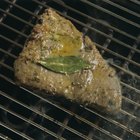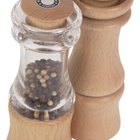
Dining on seafood, such as wild salmon, sea bass, tuna, flounder and lobster, not only is a pleasurable dining experience, but it contributes to a wide range of health and nutritional benefits. When you purchase frozen seafood or pull seafood packages from your freezer, you expect quality seafood. However, seafood packaged poorly causes air to enter the package, resulting in freezer burn. Freezer burn happens when the moisture on the seafood's surface evaporates. Although the U.S. Department of Agriculture (USDA) claims eating freezer burned foods is safe, recognizing freezer burn early can help you enjoy quality seafood.
Examine the seafood package for tears or holes before opening it. Do not buy the frozen seafood if you see any openings or crushed edges. If you already have a frozen package with holes, the seafood probably has freezer burn, which lowers its quality.
Inspect the seafood for light-colored areas or gray-brown spots that feel like leather. The seafood has dried out in these areas and has freezer burn, although it can still be safely eaten. Throw out any seafood you see that is heavily freezer burned, because the quality of the fish has been greatly compromised.
Smell the seafood before purchasing or preparing it. Seafood with freezer burn will not have a foul odor, but it will not smell fresh, either. Fresh seafood has a mild smell, as if it just came out of the sea. Cut out the freezer burned spots with a fillet knife before cooking. Avoid purchasing any fish with strong, sour or fishy odors.
Recognize freezer burn on your seafood if you encounter tough pieces to chew or if the seafood has an "off" flavor. The seafood will not harm you, but its low quality can affect your dining enjoyment. Cut out any freezer burned pieces, if possible, before consuming the fish.
Related Articles

Can I Cut Freezer-Burn Off a Tuna Steak ...

How to Freeze Catfish

How Can I Tell If Lunch Meat Has Gone ...

Can You Fry Frozen Tilapia?
How Long Does Cooked Lobster Stay Fresh?

How Long Can Grilled Octopus Keep?

Calories in Subway Seafood Salad

How to Smoke Carp

How to Thaw Lobster in the Microwave

How Long Does Tilapia Last Refrigerated?

How Fast Does Cooked Spaghetti Squash ...

Can I Cook Chicken Two Weeks After the ...
How Long Can Halibut Be Kept Frozen?

How Long Can Tuna Stay Fresh?

How to Make Seafood Salad

All You Can Eat Lobster Restaurants in ...

How Long Do You Keep Meat in Freezer?
Can You Use Stew Meat That Has Been ...

How to Brine Trout to Smoke

How Long Can Meat Stay out of the ...
References
Writer Bio
Chyrene Pendleton has been a business owner and newsletter editor for more than seven years. She is a freelance writer with over 25 years experience and teaches a variety of topics, including alternative health, hair care and metaphysics. Pendleton is a certified television show producer, radio talk-show host and producer, and a computer programmer with a bachelor's degree in computer science.
Photo Credits
Jupiterimages/Goodshoot/Getty Images